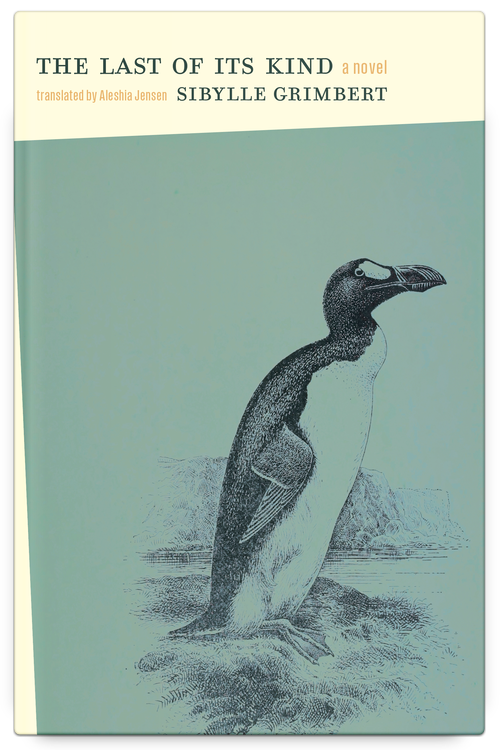The Last of Its Kind by Sibylle Grimbert, translated by Aleshia Jensen
Reviewed by Lisa Timpf
Sibylle Grimbert’s The Last of Its Kind is a work of historical fiction. Despite its grounding in the past, this novel has much to say to readers in the present.
The novel’s events begin in 1835, when a young zoologist named Auguste (Gus for short) encounters a wounded great auk. Gus, who had been sent to Iceland by the Natural History Museum of Lille to study North Atlantic fauna, has just witnessed the slaughter of a colony of great auks when he finds and rescues this injured survivor.
“The Last of Its Kind depicts the struggle to come to grips with the reality of extinction.”
Initially, he plans to send the bird, who he names Prosp (short for Prosperous) to the Museum of Lille as a specimen. But as he spends more time with Prosp, Gus finds himself unable to part with the bird. Since there is a booming market for great auk parts (skins, beaks, feathers, and so on), Gus is forced to relocate to keep Prosp safe from kidnapping, as some of the local fishermen have been eyeing him up as a potential source of income. Gus and Prosp move to the Faroe Islands, where Gus meets his wife-to-be.
As time progresses, Gus continues his zoological surveys while becoming fascinated with Prosp and his behaviours. Affection and trust develop between man and bird. Meanwhile, there are increasing reports about the increasing scarcity of great auks, and their absence from customary nesting sites.
At first, Gus and his contemporaries believe that creatures like the great auk have simply relocated—a fanciful notion that is nonetheless somewhat plausible given that there were, at the time, regions of the world not yet fully explored. Gradually, Gus comes to acknowledge the truth: that it’s not only possible, but likely, that Prosp is the last living representative of his species. Through Gus’s thoughts and conversations, The Last of Its Kind depicts the struggle to come to grips with the reality of extinction.
The fictional interactions between Gus and Prosp demonstrate the numerous similarities we share with the creatures who co-habit the planet, while at the same time recognizing the inevitable gaps in our ability to communicate with other species.
As a work of historical fiction, The Last of Its Kind is convincingly written. As indicated in the Author’s Note, there is no historical reference to a relationship between a human and a great auk like the one portrayed in the novel. Nonetheless, The Last of Its Kind convincingly conveys how a relationship of this kind might have played out.
The Author’s Note also states that numerous books about great auks, theories of regarding extinction, the Faroe Islands, and other items were consulted in preparing the novel. In the “Translator’s Note,” translator Aleshia Jensen adds that she consulted similar references, as well others. Jensen even visited the penguins at the Montréal Biodôme to get a sense of what some of Prosp’s mannerisms might have looked like. The thoroughness of research done by the author and translator likely contributed to the novel’s aura of authenticity.
The Last of Its Kind was originally released in 2022 in French, with the title Le dernier des siens. Jensen’s translation is skilfully done, with the story reading smoothly.
Just like the scientists of the 1800s coming to grips with the reality of extinction, humans of the present day struggle with grasping the impacts of climate change and the potential for a “sixth wave” of extinction. The Last of Its Kind offers a timely and poignant reminder that what seems to be unthinkable may in fact be all too real, while at the same time encouraging compassion for the creatures affected by humans’ actions.
About the Author
Sibylle Grimbert’s eleventh novel, Le Dernier des siens (2022) was a finalist for the Femina, Renaudot, Femina Lycéens, and Renaudot Lycéens prizes, and the Grand Prix de l’Académie française. The book has been translated into many languages, including English as The Last of Its Kind (tr. by Aleshia Jensen), and an animated film is forthcoming. Grimbert is also a recipient of the prestigious Maurice Genevoix Prize from the Académie Française, the 30 Millions D’Amis Literary Prize, the François Sommer Prize, and the Joseph Kessel Prize. She lives in Paris.
About the Translator
Aleshia Jensen is a literary translator and former bookseller living in Tio’tia:ke/Montréal. A four-time finalist for the Governor General’s Literary Award for Translation, Jensen translates Quebec and French fiction and indie comics. Her translations include Remnants by Céline Huyghebaert, Prague by Maude Veilleux, in co-translation with Aimee Wall, as well as graphic novels by Mirion Malle, María Medem, and Camille Jourdy.
About the Reviewer
Lisa Timpf lives in Simcoe, Ontario, where she writes poetry, book reviews, short stories, and creative nonfiction. Lisa’s speculative poetry collections Cats and Dogs in Space (2025) and In Days to Come (2022) are available from Hiraeth Publishing in print and electronic formats. Lisa is a member of SF Canada and the Science Fiction and Fantasy Poetry Association. You can find out more about her writing projects at http://lisatimpf.blogspot.com/. Lisa is also on Bluesky, @lisatimpf.bsky.social
Book Details
Publisher: Book*hug Press
Publication date: Nov. 11 2025
Language: English (translated from original French)
Length: 160 pages
ISBN-13: 978-1771669580




